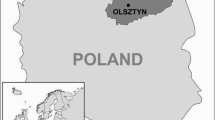Abstract
A study to evaluate the natural rate of infection ofIxodes ricinus withBorrelia burgdorferi sensu lato was carried out in an endemic focus of Lyme disease in the Trieste area in northern Italy. Two-hundred and twenty-seven ticks collected in ten different stations were tested individually for the presence of the spirochetes using polymerase chain reaction techniques able to identify bothBorrelia burgdorferi sensu lato and the four genospecies (Borrelia burgdorferi sensu stricto,Borrelia garinii, Borrelia afzelii and group VS116). Multiple infection of individual ticks was found. The infection rate ranged from 0–70%. Infection ofIxodes ricinus withBorrelia burgdorferi group VS116 was found for the first time in Italy in both a high and a low endemic focus of Lyme disease.
Similar content being viewed by others
References
Burgdorfer W, Barbour AG, Hayes SF, Benach JL, Grunwaldt E, Davis JP: Lyme disease — a tick borne spirochetosis? Science (1982) 216:1317–1319
Crovato F, Nazzari G, Fumarola D, Rovetta G, Cimmino MA, Bianchi G: Lyme disease in Italy: first reported case. Annals of Rheumatological Diseases (1985) 44:570–571
Trevisan G: Epidemiologia della borreliosi di Lyme nel Friuli Venezia Giulia. Annuali Italiani di Dermatologia Clinica Sperimentale (1990) 44:127–137
Cinco M, Banfi E, Trevisan G, Stanek G: Characterization of the first tick isolate ofBorrelia burgdorferi from Italy. Acta Pathologica Microbiologica Immunologica Scandinava (1989) 97:381–382
Cinco M, Murgia R, Bonin S, Padovan D, Stanta G: Detection of the three species ofBorrelia burgdorferi inIxodes ricinus with polymerase chain reaction in northern Italy. Alpe Adria Microbiology Journal (1996) 5:253–256
Rijpkema SGT, Molkenboer MJCH, Schouls LM, Jongejan F, Schellekens JFP: Simultaneous detection and genotyping of three genomic groups ofBorrelia burgdorferi sensu lato in DutchIxodes ricinus ticks by characterization of the amplified spacer region between 5S and 23S rRNA genes. Journal of Clinical Microbiology (1995) 33:3091–3095
Sambrook J, Fritsch EP, Maniatis T: Molecular cloning — a laboratory manual. Cold Spring Harbor Laboratory Press, Cold Spring Harbor (1989)
Olsen B, Duffy DC, Jaenson TGT, Gylfe A, Bonnendahl J, Bergstrom S: Transhemispheric exchange of Lyme disease spirochetes by seabirds. Journal of Clinical Microbiology (1995) 33:3270–3274
Marconi RT, Garon CT: Development of polymerase chain reaction primer set for diagnosis of Lyme disease and for species specific identification of Lyme disease isolates by 16S rRNA signature nucleotide analysis. Journal of Clinical Microbiology (1992) 30:2830–2834
Don RH, Cox PT, Wainwright BJ, Baker K, Mattick JS: Touchdown PCR to circumvent spurious priming during gene amplification. Nucleic Acids Research (1991) 19:4008
Sharkey DJ, Scalice ER, Christy KG, Atwood SM, Daiss JI: Antibodies as thermolabile switches: high temperature triggering for the polymerase chain reaction. Biotechnology (1994) 12:506–509
Maroli M, Khoury C, Frusteri L: Diffusione diIxodes ricinus (Acari: Ixodidae) in Italia. Ecobiologia e ruolo della specie nella trasmissione di patogeni. Giornale Italiano di Malattie Infettive (1995) 1:269–278
Aeschlimann A:Ixodes ricinus Linné 1758. Essai preliminaire de synthèse sur la biologie de certe espéce en Suisse. Acta Tropica (1972) 29:321–340
Kirstein F, Rijpkema S, Molkenboer M, Gray JS: The distribution and prevalence ofBorrelia burgdorferi genomospecies inIxodes ricinus ticks in Ireland. European Journal of Epidemiology (1997) 13:67–72
Randolph SE, Gern E, Nuttall PA: Co-feeding ticks: epidemiological significance for tick-borne pathogen transmission. Parasitology Today (1966) 12:472–479
Gern L, Burgdorfer W, Aeschlimann A, Krampitz HF: The ecology of Lyme borreliosis in Europe. In: Weber K, Burgdorfer W (eds) Aspects of Lyme borreliosis. Springer, Berlin Heidelberg New York, (1993) pp 59–69
Peter O: Lyme borreliosis in the state of Valais, Switzerland. Journal of the International Federation of Chemistry (1990) 2:121–124
Miserez V, Gern L, Aeschlimann A:Bonelia burgdorferi in ticks of the Canton Tessin (Switzerland). Parassitologia (1991) 32:293–299
Author information
Authors and Affiliations
Rights and permissions
About this article
Cite this article
Cinco, M., Padovan, D., Murgia, R. et al. Rate of infection ofIxodes ricinus ticks withBorrelia burgdorferi sensu stricto,Borrelia garinii,Borrelia afzelii and group VS116 in an endemic focus of Lyme disease in Italy. Eur. J. Clin. Microbiol. Infect. Dis. 17, 90–94 (1998). https://doi.org/10.1007/BF01682162
Issue Date:
DOI: https://doi.org/10.1007/BF01682162




